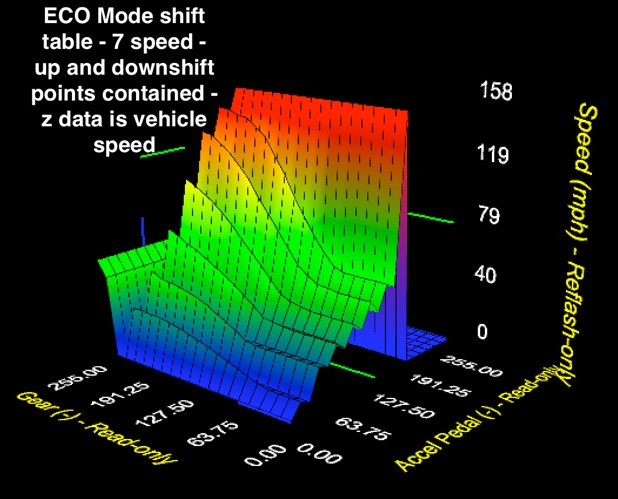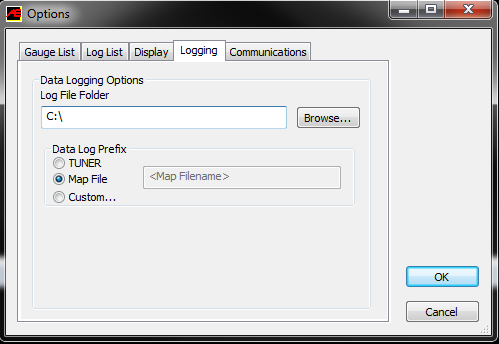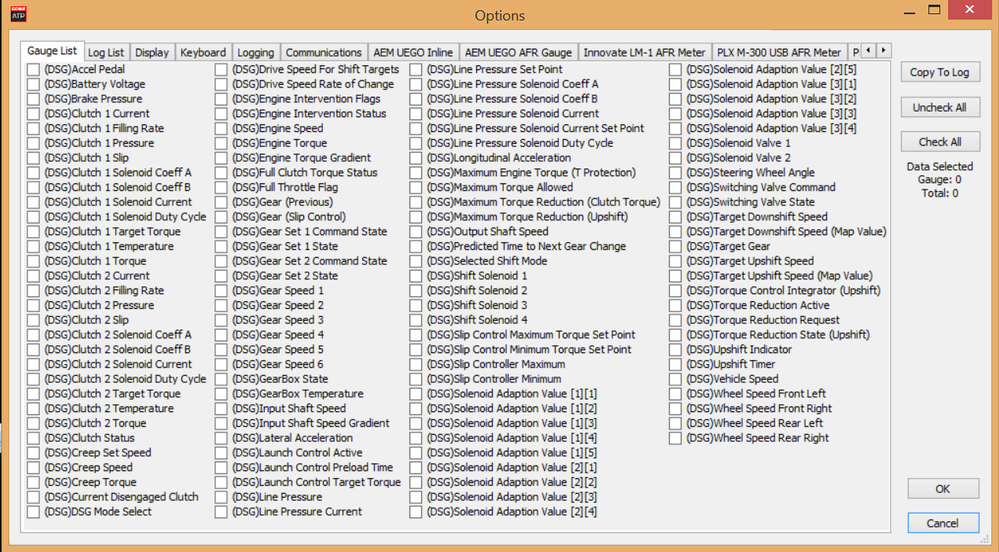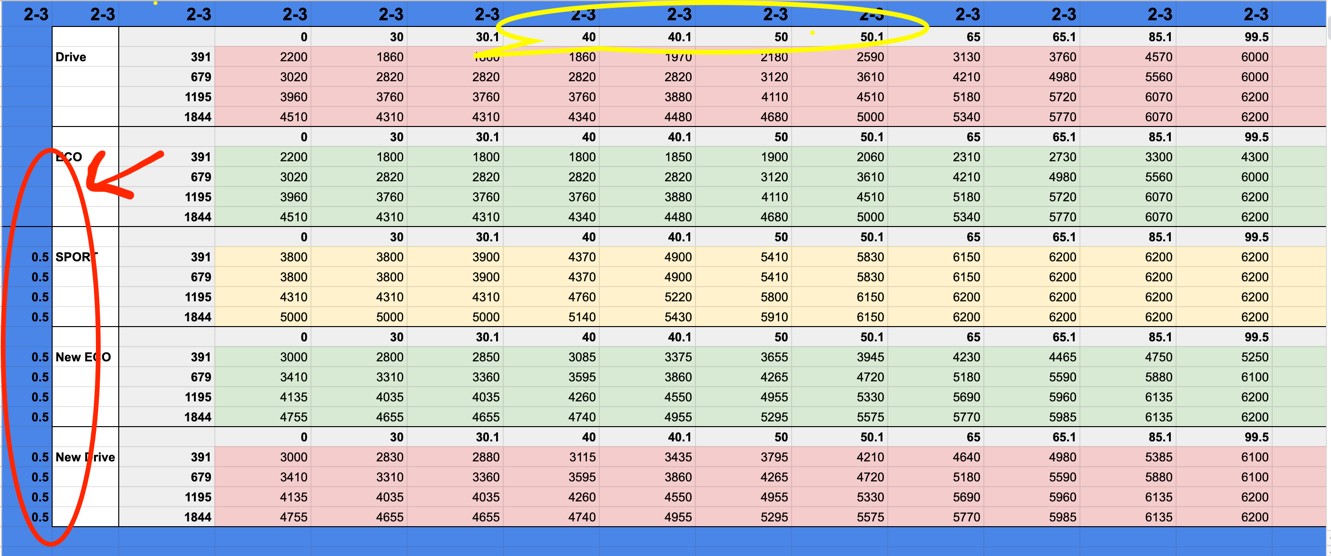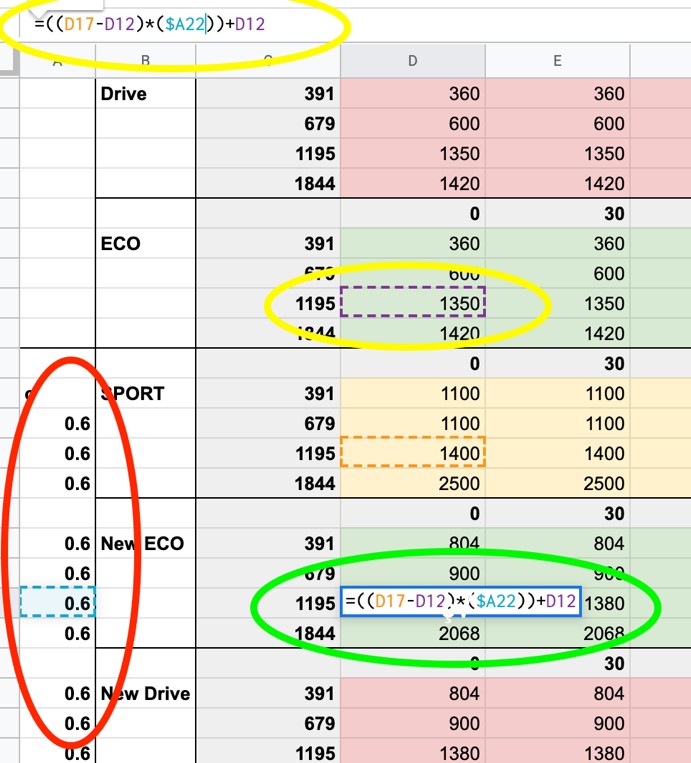Volkswagen MQB 6 Speed DSG Tuning Guide
What is MQB?
MQB refers to a platform shared amoung many of the Volkswagen Auto Group (VAG) companies.
Modularer Querbaukasten (Modular Transverse Matrix)
The Transverse mounted front-wheel-drive or All-wheel-drive platform upon which multiple cars have been driven. Among which COBB Offers support for:
- MK7 GTI
- MK7 Golf R
- MK7.5 GTI
- A7 Jetta GLI
- Audi 8V S3
- Audi 8V A3
Getting to know the MQB VW DSG
Here we will go over a few of the basic details and terminologies that are specific to VW MQB 6 Speed DSG before we begin tuning on a COBB Accessport equipped Volkswagen.
- Basic characteristics: The 6 Speed DSG transmission is similar to the 7 speed in overall design. There are two clutches bathed in transmission oil that are made up of friction disks and clutch plates. One of these clutches manages gears the odd gears and reverse. The other clutch set is responsible for transmitting clamping force to the even gears. The pressures in this wet clutch system are managed via solenoid duty cycle and closed loop clutch pressure targets. 6 speed DSG transmissions are known to hold slightly less torque that the later 7 speed cars even in stock form. The 7 speed transmission is a newer variant and is a newer design overall.
- Shift Modes – The Volkswagen MQB 6 Speed DSG has 3 or more shift modes depending on the tables which are being modified. The main 3 modes are Drive (normal), Sport, and Tiptronic (TT). Depending on the vehicle configuration, there may be additional modes available, such as ECO (Economy), and ALT (High Altitude).
- Drive and Sport modes are the main influence on current gear choice. In these modes the DSG will choose the correct gear based upon
- Axle torque
- Throttle position
- Engine RPM
- Recent driving behavior / timed behavior changes.
- Tiptronic Function (manual shifting) - Is selected using the factory paddles or by placing the shifter in the manual shifting (Tiptronic) position. Within each of these drive modes there are more tables and logic to further define their function.
- Drive and Sport modes are the main influence on current gear choice. In these modes the DSG will choose the correct gear based upon
Shift Schedule tables. The majority of your work for custom tuning DSG will be in shift tables. The standard shift schedule for the GTI, A3, S3, Golf R and other variants are very conservative and create a very subdued and lackluster “automatic mode” driving experience. The very low RPM upshift points keep the cars well out of the RPM range for best power and responsiveness. The shift schedule tables are structured differently for 6 and 7 speed. 7 speed tables contain up and downshift components in ONE table and they are based upon vehicle speed z data. 6 speed tables are based upon axle torque and throttle position and the z data is engine speed. Each table contains only upshift OR downshift data. Upshift and downshift are segregated. This segregation and relation to axle torque makes calibrating 6 speed shift schedules particularly challenging.
In a later section of this guide we’ll go into great detail about how to adjust these tables to produce the desire shift points. Remember, these tables are used only for “automatic” modes (ECO, Normal, and Sport) but are not utilized for any TT mode.6 speed shift schedule table structure compared 6 speed tables are based upon axle torque and throttle position and the z data is engine speed. 7 speed tables contain up and downshift components in ONE table and they are based upon vehicle speed z data.
- Torque Based – The VW DSG operates based on requests and inputs from the ECU. In factory form there are hard limits to the amount of torque that can be requested from the DSG transmission in the background. These limits have been removed permanently and can not be adjusted / calibrated. Any DSG maps flashed to the DSG will have these limits removed. In addition to these limits there are additional ones which can be seen and modified from inside the software. Generally it has been found that raising them very high to remove them completely has no negative side effect. The line pressure and the clutch pressure are DIRECTLY LINKED to the output torque received from the ECU. At this time we do not have any additional ways to modify the clutch pressure independent of the input torque from the ECU.
Commonly Used Acronyms
|
|
The Tuning Guide
This tuning guide is divided into the basic components of tuning the VW DSG and the tables associated with each of these components. For each major tuning category, the guide outlines basic tuning strategies and defines tables within this category (for example: Boost Control, Fueling, and Ignition Timing). Table descriptions and tips can be found located in Accesstuner software.
Step 1 – What is the mechanical configuration of the vehicle?
The first step in tuning is choosing a COBB Tuning Off-The-Shelf (OTS) calibration that most closely matches the mechanical components and modifications of the transmission to be tuned.
All COBB DSG Maps incorporate increased line and clutch pressure abilities, faster shifting, and gear display on the dash.
Shift Points Available, which incorporate the above features:
| TQ Limit Removed | Gear Display In All Modes | Shift Delay In Manual | Shift Time REduction | Kickdown Disabled in TT | Launch Counter DIsabled | |
|---|---|---|---|---|---|---|
| Installed Stock | ||||||
| COBB OEM+ | X | X | X | X | X | X |
| COBB Sport | X | X | X | X | X | X |
| COBB Aggressive | X | X | X | X | X | X |
| COBB Aggressive IS38 | X | X | X | X | X | X |
INFORMATION ABOUT THE GTI OTS MAPS
INFORMATION ABOUT THE Golf R OTS MAPS
Warnings
- If the vehicle being dyno tested is equipped with Active Lane Keep (Assist) it must be disabled as unexpected steering input could result causing a loss of control on the dynamometer.
- The Golf R is capable of operating in dyno roll test mode, this deactivates the AWD system and will run in FWD only mode. The Golf R uses the Haldex system, which incorporates an electro-hydraulic clutch to send power to the rear wheels. These clutch type coupling systems can generate excessive heat and wear under heavy load/long time operation on un-linked type chassis dynamometers caution is advised.
Preparation for Calibration
Connect the Accesstuner software to the Accessport equipped VW DSG
Open the selected starting point calibration in the Accesstuner software. Configure the Accesstuner software to connect to your vehicle. Attach the OBDII cable to the vehicle and the associated USB to the computer and Accessport. Press "Ctrl+F" to configure the program. Select the directory in which to store your data logs under the "logging" tab.
Display and Log critical parameters while testing
Accesstuner software allows the user to visualize, sample and record critical engine parameters including sensor information and commanded transmission function.
To setup displayed parameters on the live "Dashboard" press "Ctrl+F" to configure the logged parameters in the "Log List" tab, and those displayed in the Accesstuner "Dashboard" through the "Gauge List" tab. The Dashboard, a screen that reports active transmission and sensor parameters, can be accessed by pressing "Ctrl+B." It is critical to actively monitor the condition of the motor during tuning and this screen is the single best way to do so. These data monitors allow the tuner to determine if a calibration is performing correctly. Accurate and deliberate assessment of logged parameters is the only way to avoid conditions that may damage the transmission.
Hint: Configure recorded parameters in the "Log List" tab
While connected to a running vehicle press "Ctrl+F" and select the "Log List" tab to select the parameters displayed in saved Accesstuner logs. When data logging is enabled (Ctrl-D) these parameters will be permanently written to a comma delimited data file.
This is a screen shot of some of the available parameters to display in the live dashboard gauges (Gauge List tab) or to be recorded in the data log file (Log List tab). The most up to date list of monitors is always available here - Volkswagen Monitor List - Mk7 GTI Golf R (DSG)
Below is a list of helpful parameters for the VW DSG. The selected parameters are those that are critical to record under most conditions. Other parameters may be selected or removed based upon the objectives of any specific tuning process.
(DSG)Accel Pedal
(DSG)Clutch 1 Pressure
(DSG)Clutch 1 Slip
(DSG)Clutch 1 Solenoid Duty Cycle
(DSG)Clutch 2 Pressure
(DSG)Clutch 2 Slip
(DSG)Clutch 2 Solenoid Duty Cycle
(DSG)Engine Intervention Flags
(DSG)Engine Intervention Status
(DSG)Engine Intervention Type
(DSG)Engine Speed
(DSG)Engine Torque
(DSG)Gear Box State
(DSG)Gear Box Temperature
(DSG)Launch Control Active
(DSG)Line Pressure
(DSG)Line Pressure Set Point
(DSG)Line Pressure Solenoid Duty Cycle
(DSG)Target Gear
(DSG)Target Upshift Speed
(DSG)Torque Reduction Active
(DSG)Vehicle Speed
Calibration Refinement
Current OTS (Engine) maps have Launch Control (LC) enabled in them. The COBB LC system uses rear wheel speed to activate the system. In order to run the car on a 2wd dyno you need to turn the LC Master Switch in AccessTuner to OFF (0). Alternatively you can change the vehicle to traction control Slot 9, which will also completely disable the system.
For more information visit our traction control article here COBB Custom Features: COBB Traction Control on MQB Vehicles
A: Adjusting Clutch and Line Pressure
As mentioned in the 'Getting to know the MK7 VW DSG" section, the main control of line pressure and clutch pressure is directly related to the torque the motor is producing, which is being sent to the DSG from the ECU. There are limits to the amount of torque which can be requested which need to be removed. If you open one of the DSG OTS maps and compare to the stock map, you can see them and adjust them further if you wish. It is possible to raise the line pressure by using the 'Line Pressure Temperature Compensation' separately, but this will not have a direct effect on the clutch pressure. The ability to control the PID gain for the clutch control solenoids is available in the 'Solenoid Control Tables' folder, where you will also find Solenoid 1 and 2 Maximum Current. It may be necessary to raise these values. You can log and verify this as well.
B: Adjusting Shift Points
The 'Shift Schedule Tables' folder contains the 'main' tables which handle a majority of the shift scheduling unless other special modes are in play. 'Shift RPM Limit and Override Tables' are active when the 'Forced Upshift Enable' Switching this value from 7 to 3 will disable the forced shift tables from occurring in TT mode. To disable Sport and TT mode set this value to 2. To disable in Drive mode as well, set this to 0. When removing these tables from play the shift rpm in the shift schedule tables will be used. In TT mode you will be able to hit the rev limiter since there are no shift points defined for it.
COBB OTS calibration approach for shift schedule:
After a lot of time driving these DSG 6 speed transmissions our impression was that Sport mode was perfect for very spirited driving but that Normal mode shift schedules were not aggressive enough. The car tended to use higher gears to early in the rev range. To create a balanced map we blended ECO (normal) and Sport mapping. These first OTS maps were done as a blend. You can see how this was accomplished un the bottom section of these tuning guide spreadsheets. There are several tabs for 6 speed DSG tuning here: These spreadsheets set up a template to allow a blending of sport and normal. Each table supports one specific upshift or downshift. You can see here (yellow highlighted oval) that this table is for the 2-3 upshift. The upper part of the table contains the stock “drive”, “eco”, and “sport” shift tables for the 2-3 upshift.
Here we are blending the lowest performance ECO tables with the sport tables by a factor of 0.5 (left RED oval). The formula that does this (YELLOW) simply takes the difference between sport and Eco and multiplies this by our difference factor (RED) and then adds that value to the ECO table to give the final and new ECO table (GREEN). These values are then pasted back into the calibration. This transformation is done for EACH upshift table (1-2, 2-3, 3-4, 4-5, 5-6) as well as each downshift table (2-1, 3-2, 4-3, 5-4, 6-5). This is laborious but we have found considerable success using this approach of mathematical transformation.
The proportion of change for COBB OTS maps across each gear is different. COBB OTS maps use an incrementing decrease in change with higher gears. This produces a more sporty drive experience but allows the car to perform more like stock at higher speeds and higher gears. COBB aggressive and sport proportional changes are listed here for your convenience and understanding.
Sport | Aggressive | |
|---|---|---|
1-2 and 2-1 | 0.6 | 0.7 |
2-3 and 3-2 | 0.5 | 0.5 |
3-4 and 4-3 | 0.3 | 0.4 |
4-5 and 5-4 | 0.2 | 0.3 |
5-6 and 6-5 | 0.005 | 0.01 |
C: Stall Speed Tables
These tables are the effective rpm set point for the engine when the clutch has not yet fully engaged. Adjusting them will have an effect on how smooth the clutch take up will be on/off coasting and from a dead stop when the clutch is not yet fully engaged.
D: Precautions
Clutch
During development it was found that power levels in excess of ~390 Ft. lbs. could cause early clutch failure. If slippage is noticed it is recommend to reflash to a lower power level to avoid further damage.
Launch Control Stall Speed
Take care to set the 'Stall Speed (Launch Control)' tables to values that are lower than value you are using in the ECU mapping. It is OK to set the RPM in the ECU map much higher than the value in the DSG, but not the other way around.
Contact Us:
COBB Customer Support
Web Support and Tech Articles: COBB Tuning Customer Support Center
Email: support@cobbtuning.com
Phone support available 9am to 6pm Monday-Thursday. 9am to 4pm Friday (CST)
866.922.3059
return to www.cobbtuning.com
Related content
Copyright 2025 © COBB Tuning Products LLC. All Rights Reserved. | www.cobbtuning.com

